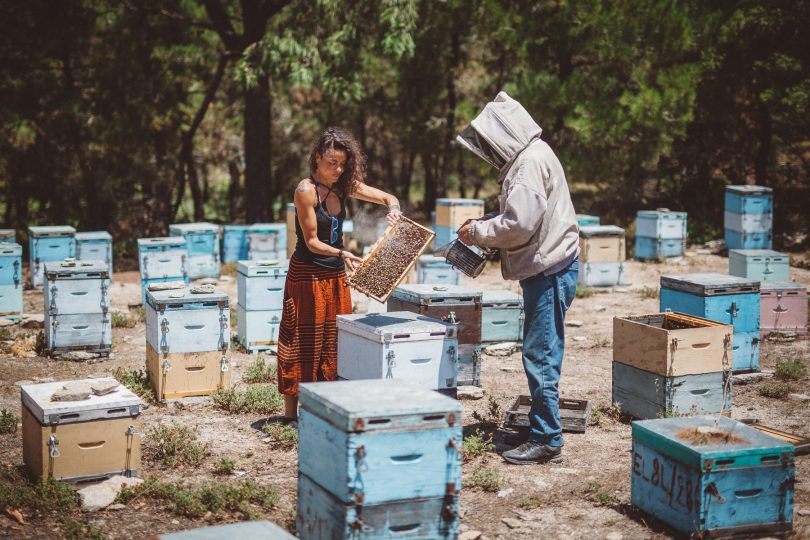The honeybees, we are told, are dying. Our world has pervaded their sanctuaries, and a crucial pollinator of our crops has been taken for granted. Some people chemically treat lawns decorated with dandelions and clover that the bees cherish. What’s a “perfect lawn”, anyway, and who cares? We’ve used synthetic pesticides on mono-cultured crops. Maddeningly, when you research the topic on the World Wide Web, you’re met with a barrage of antithetical information. Like climate change.
Outside of the fight over the honeybee, when you shut out the noise and chatter from a thousand different directions, and simply focus on the bee itself, you’ll be spellbound. I know, because I’ve tried this, and what I have to tell you is transfixing. Part of my honeybee education was learning why the honeycomb is hexagonal. I know the answer, but I’m not going to divulge all of the bees’ secrets. Watch the Netflix documentary The Code, Episode 2.
Honeybees and plants can communicate with each other. Sometimes a plant will propel specific volatile molecules into the ether, a molecular Bat-Signal. And their tantalizing calls are often answered by a life form who digs what the plant is saying, whether an insect like a honeybee or predatory mite, or any one of us. Thus, terpenes are considered a mode of communication. [1] A honeybee can distinguish between the scents of the flowers of different cultivars, enabling them to choose which is most attractive to them. [2]
The bewitching terpenoid geraniol is in some of my favorite plants, including roses, geraniums, catnip, beebalm, Assam tea, lemongrass, grapes, citronella, and Citra hops. It’s also one of the main constituents of the Nasonov pheromone that is released by worker honeybees to help acquaint bees pulling a 9 to 5 out foraging to the entrances of their homes when they return. [3]
Honeybees are also preferentially drawn to ocimene, myrcene and limonene. [4] Perhaps analogous to an infant’s crying, trans–β-ocimene is a pheromone produced by honeybee larvae to chemically verbalize their nutritional needs to worker bees. [5] Interestingly, it serves the dual function of suppressing ovary development, thereby helping worker bees transition from nurses to foragers. Newly hatched to three-day old larvae produce the highest concentrations of the monoterpene, thus highlighting that trans–β-ocimene is predominantly released during fragile stages of development when the larvae must effectively communicate with their caretakers. Another study evaluated the foraging activity of worker bees in response to trans–β-ocimene levels within the hive. [6] This research group likewise concluded that the monoterpene plays a paramount role within beehives as a chemical phone line between larvae and workers.
When you begin to understand the complex interplay between plants and honeybees, or just between the bees, and when you discover for yourselves the levels of sophistication going on inside the hive, it’s easy to see that these bees are civilized. The plants need them, and you and I need them. So, who really cares what the talking heads say you should think regarding who or what is killing the bees? What’s important is focusing our minds on scientifically studying their unspoken, poetic language of chemicals and math, and making damned sure we do what we can to protect their ecosystem, whether they are classified as endangered or not, and whether you are Monsanto [7], or just a hobbyist gardener like me.
References
[1] Gershenzon, J., and Dudareva, N., “The function of terpene natural products in the natural world”, Nature Chemical Biology, 2007, Volume 3: Pages 408–414. [journal impact factor = 15.066; cited by 1169] [2] Wright, G. et al., “Intensity and the ratios of compounds in the scent of snapdragon flowers affect scent discrimination by honeybees (Apis mellifera)”, J. Comp. Physiol. [A], 2005, Volume 191: Pages 105–114. [journal impact factor = 15.066; cited by 114] [3] Free JB. Pheromones of Social Bees. Ithaca, NY: Cornell University Press, 1987. [4] Waller, G. et al. “Olfactory Discrimination by Honeybees of Terpenes Identified from Volatiles of Alfalfa Flowers”, Journal of Apicultural Research, 1974, Volume 13(3): Pages 191-197. [journal impact factor = 1.015; cited by 24] [5] Maisonnasse, A. et al. “E-β-Ocimene, a Volatile Brood Pheromone Involved in Social Regulation in the Honey Bee Colony (Apis mellifera)”, PLoS ONE, 2010, Volume 5(10): e13531. [journal impact factor = 2.766; cited by 66] [6] Ma, R. et al. “Assessing the role of β-ocimene in regulating foraging behavior of the honey bee, Apis mellifera”, Apidologie, 2016, Volume 47: Pages 135–144. [journal impact factor = 2.856; cited by 5] [7] Motta, E. et al. “Glyphosate perturbs the gut microbiota of honey bees”, PNAS, 2018 115 (41):Pages 10305-10310. [journal impact factor = 9.504; cited by 16]Image used with permission of Maryam Herein, Director of Vanishing of the Bees.








